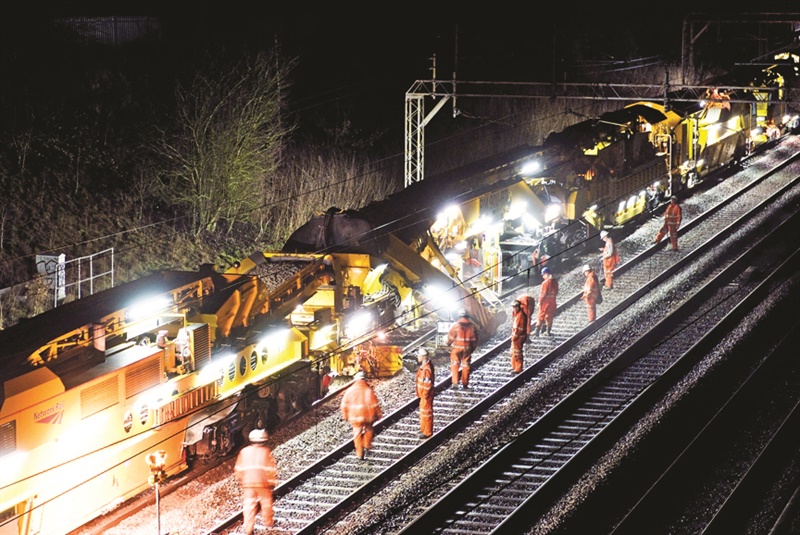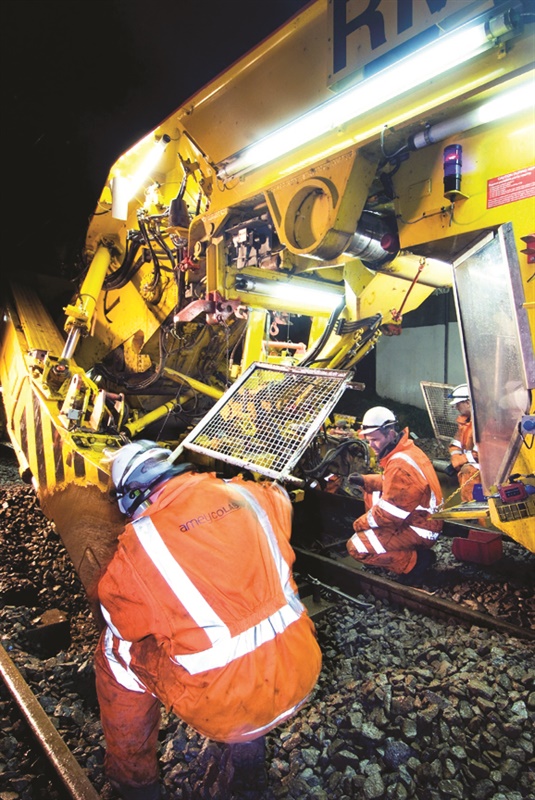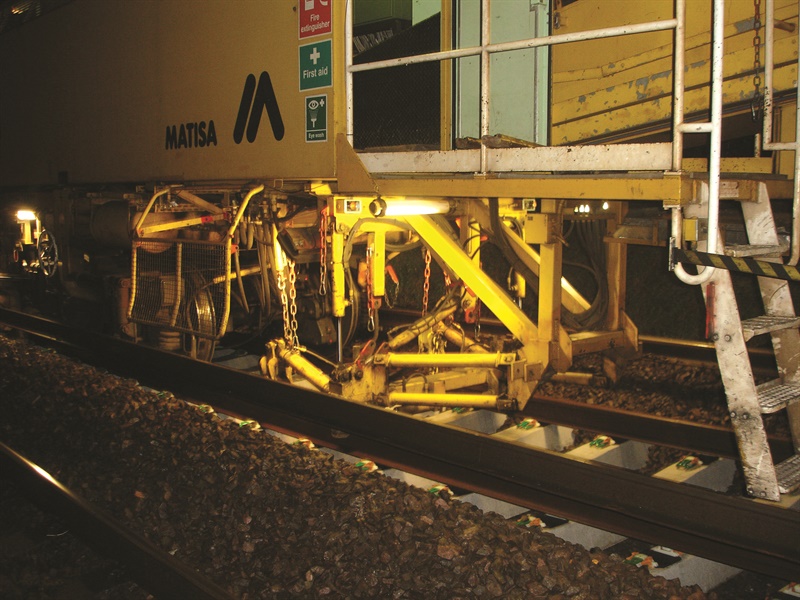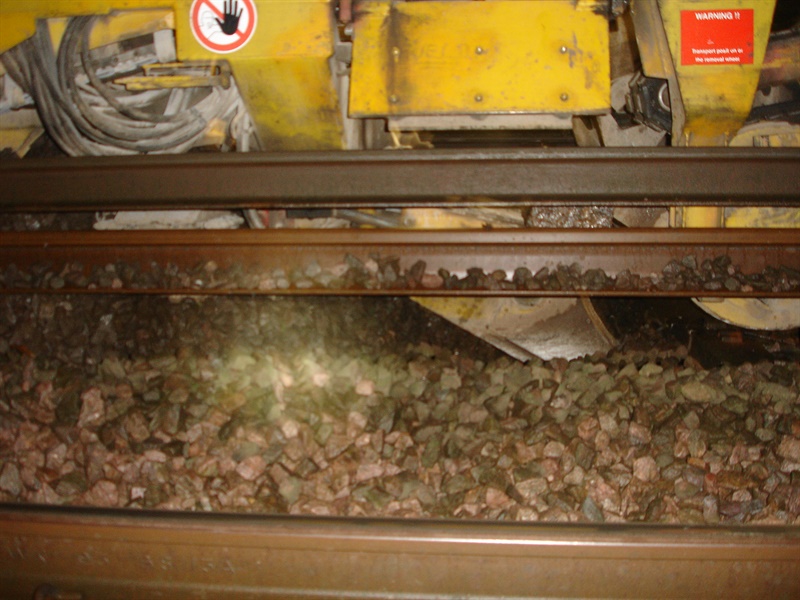12.05.14
Network Rail to bring high output track renewals in-house
About 600 workers who have been delivering high output track renewals for Network Rail are to be transferred into the company as employees in a rare example of ‘insourcing’.
Network Rail says that taking direct control by insourcing its principal contractor team when the existing contract expires in March 2015, rather than re-tendering the contract, will create a “less complex” organisation with “greater stability”.
The rest of the 1,200 people involved with the £250m high output track renewals contract are either Network Rail employees already (about 100 people), or work for subcontractors to the existing AmeyColas JV, some of whom may also be transferred into Network Rail.
High output track renewals allow Network Rail to replace more and more track while allowing trains to run safely on adjacent lines, minimising disruption to services.
Steve Featherstone, Network Rail track programme director, said: “Our full-time, professional high output track renewals workforce is fundamental to delivering a safe, reliable railway.
“By creating a single team within Network Rail we can make step changes in training and development in order to further improve safety and productivity within this key part of the industry.”
Network Rail will work jointly with AmeyColas to deliver high output track renewals up to the point of transfer and is now working closely with both the RMT and TSSA to manage a smooth transfer of the people affected.
Tell us what you think – have your say below or email [email protected]

Just over a year ago, RTM saw the team operating the TRS2 high output track-relaying train ‘factory’ in action in Derbyshire. The resulting story is reproduced below:
Network Rail’s two track re-laying machines, TRS2 and TRS4, plus its three sophisticated BCS ballast cleaning systems, make up its High Output Plant service – which gets an amazing amount of work done in relatively little time and makes best use of overnight possession windows.
The machine is really more of a factory, and is 800 metres long when the sleeper wagons and auto-ballasters that accompany it are taken into account, weighing 415 tonnes.
With a midweek delivery record of 864 metres (four rail lengths) in seven hours, it is not just high output but fast output, automating and mechanising processes that take teams of men far longer.
High output vs conventional renewals
Of course, there is a big cost attached, but as Network Rail’s track delivery manager Ben Brooks told RTM on our Thursday night site visit to see TRS2 in action: “The unit cost of track renewal via high output – a combination of ballast cleaning and track re-laying – is now the same, in effect, as conventional renewals. So if I came along and renewed this stretch in 30-hour blocks using conventional methods, it would cost me the same asrunning this factory operation mid-week.
“But we wouldn’t be able to physically get the amount of weekend access to be able to do the work conventionally. One of the big reasons we need the high output capability is because the railway can’t sustain the amount of weekend access we need to deliver this volume of renewals. It’s a no-brainer: we have to have a way of doing this midweek.
“Our conventional programme tends to target smaller locations with more immediate problems, whereas our high output programme is a bigger, more strategic approach.”

Plain line only
The method does have some limitations – it is currently only appropriate for simple stretches of plain line: no S&C, no platformed sections, no tunnels or viaducts, for example. “Any structural clearance issues automatically take us to a conventional renewal,” Brooks said.
Similarly, with the ballast-cleaning high output machines, anywhere that requires any underlying formation treatment will be done conventionally, such as where deeper digging is required or geo-textile is being put in under the track.
The number of workers required on site is “broadly similar” to conventional renewals, Brooks suggested: 40-50 people on the core site when RTM visited, with around 30 spread further out on other tasks.
The AmeyColas joint venture won the £250m contract to provide the high output service in 2009, until October 2014.
On RTM’s visit on a Thursday in November, we saw TRS2 in action: the original track relaying system that came to the UK in 2004 after being purpose-built for our network and gauge by Matisa in Switzerland. It and its cousin, TRS4, will between them lay more than half of the new sleepers in the country this year, Brooks said.
Maximising track availability
A vital advantage of the TRS trains is that they allow working with the adjacent line open (ALO). The working gauge clearance is further assisted by the sleepers being positioned longitudinally on the wagons, allowing both the wagons themselves and the gantries that move them into position to be narrower.
Brooks said: “Typical conventional renewal, of course, will replace the rail by bringing trains alongside on the other line, then loading materials to and from. With high output, we’ve got this unique operation in that we’re self-contained on the line we’re renewing.”
Safety is always the number one priority for Network Rail, but when working ALO, it is especially important. Brooks said: “There’s a massive emphasis on safety, given that we’re working with the adjacent line open every night.”
We saw this on our site visit – an East Midlands Trains Class 222 heading south came past on the adjacent line. A combination of instruction from site safety officials, loud blaring alarms, and the standard protocols when working next to an operational railway alleviated any risk from the passing train.

The process
Ahead of the TRS itself comes a Quattro RRV, digging holes for ballast from under a short section of track around four sleepers long to be moved into. This short section, with sleepers hanging on the air, is where the TRS starts its real work, after the clips have been knocked out.
With the new rail lying next to the track, the old rail is cut, and the new rail picked up by the machinery and ‘threaded’ over the old rail into place, as rotating ‘forks’ scoop the old sleepers out of the ground and away, replacing them with new ones delivered via high-speed gantry cranes from the wagons. At the joint the new rail is joined to the existing track – laid the previous night – using temporary clamps at first, and welded properly later.
While TRS2 depends on a road-rail vehicle behind it to move the old rail and drop it into the cess, TRS4 – which has only been in use for two years – has its own rail manipulator rollers/arms underneath, which automatically feed the old rail into the cess.
“We’re looking at those modifications to TRS2 to see if it’s worthwhile,” Brooks said.
Other teams and machines finish the process – welders, a tamper and a regulator. Network Rail has a fleet of eight tampers and five regulators, which work with the five pieces of high output plant. The final job is re-connecting signalling and other trackside equipment.
80mph handback
A big advantage of the high output plant and the tamping method is that the track delivery team can hand back the line at 80mph, instead of 30/50.
Brooks explained: “None of our conventional contractors are certified to use the 80mph clamping mechanism that AmeyColas uses: that’s a function of the fact that these guys are full-time professionals and we have a lot of confidence in their ability.”
A second pass of the Plasser and Theurer tamper the following night, with its Dynamic Track Stabilisation technology, brings the line speed back up to its maximum – 110mph in this case.
Resilience and recovery
As with any engineering operation depending on multiple pieces of heavy machinery working simultaneously in busy environments, often at night, problems do arise. But the high output plant is a reliable renewal method, Brooks said, especially since recovery after a fault is so much easier.
He explained: “Our ability to recover if we have a problem on this site is far better than having a 500-yard hole when we are renewing conventionally, if for example the crane that was due to install all the sleepers had failed. You’d then have a massive problem. This is a much more reliable renewal method.
“The risk on this piece of kit, in terms of failure and the impact on passengers, is minimal, because if this kit broke down now, we’d just stop work, take it out of the ground, move it out of the way, and then we’d only a five-yard piece of railway without sleepers in it.”
Much of the work doing overnight possession windows is in preparing and exiting the site – the machine itself is only running for a few hours, around two and a half the night RTM visited. It has a ‘planned operating speed’ of 350 metres per hour, and a peak speed of 550 metres per hour, but that’s limited by the speed of the P2RL turntable gantry and the Fastclipper device, Network Rail says. Each sleeper wagon, carrying five pallets of 24 sleepers each, has enough to lay 78 metres of track.

Planning ahead
While the high output team is part of Infrastructure Projects under Simon Kirby, Brooks and his three counterparts on other routes also have a ‘dotted line’ report directly into the route managing directors, highlighting how devolution is working in practice. As Brooks put it: “I’m as much a part of the LNE and East Midlands route teams, under Phil Verster and Martin Frobisher, as I am part of Steve Featherstone’s track team.”
The team plans far ahead to try to keep the systems in the same part of the country for as long as possible, rather than shifting it all over the country. Although the machine is self-powered when working, it is hauled by two locomotives to get to and from work sites.
Brooks said that for the next seven years, the two TRS machines provide the capacity needed, though the ballast cleaning volumes will increase – partly as a consequence of a new focus on single-component renewal, rather than renewing rail, sleepers and ballast altogether when the rail and sleepers don’t necessarily need replacing yet. There are plans to upgrade one of the ‘medium output’ ballast cleaners into a high output, five nights a week system.
He explained that Network Rail’s commitment to high output plant shows how concerned it is to maximise the availability of the network to its customers and the train operators. It does this both through the commitment not to over-run on individual nights’ work, but also when negotiating the right access in the first place.
TRS2 is currently working its way up to Chesterfield then back down to Derby on the Midland Main Line in a six-month campaign, renewing about half of the sleepers on the route – the ones on plain line sections suitable for high output and that need renewing. It’s working four nights a week, then at weekends is being used on routes where there is weekend-only access, currently Derby-Birmingham.
When RTM went to see TRS2 in action, TRS4 was doing a stretch north of Carlisle at weekends, and was based on the ECML north of York mid-week.
Brooks and the track team were in the process of finalising the CP5 high output plan: each route puts in a submission for how much ballast cleaning and track replacement it needs, which is then built into an optimal plan for whole control period. Brooks explained: “When we’re more than a year out, the strategy of where it’s going to be in however many years’ time is done by my team; but as soon as we’re less than a year out, it’s the AmeyColas guys who work out the details.”
High output plant in action
In a continuous process, when working with the ballast cleaner too, the TRS:
• unclips the old sleeper fastenings and removes them from the track, with a magnetic drum, for disposal;
• removes the old rail from the sleeper housings;
• removes the old sleepers from the track and transports them to the sleeper carrying wagons using gantry cranes and pallet style containers;
• levels off the ballast bed and displaces the material to the side of the track;
• places the new sleepers on the prepared ballast bed and spaces them correctly;
• positions the new rail onto the new sleepers;
• fastens the new rail to the new sleepers;
• collects the new ballast and distributes it back to the newly installed track, ready for final geometry correction with a tamping machine.
Tell us what you think – have your say below, or email us directly at [email protected]